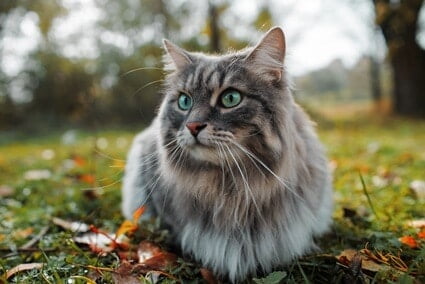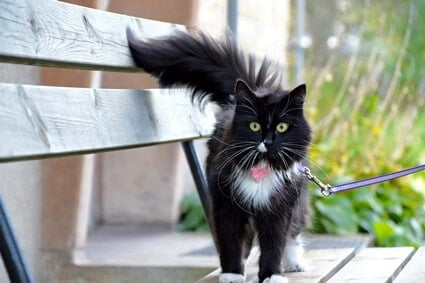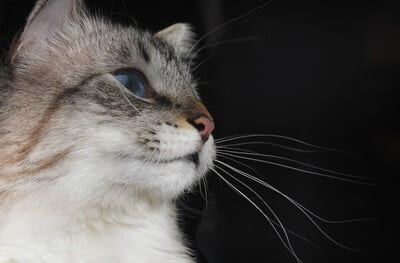Whiskers are one of a cat’s most identifiable features. They serve more purpose than mere aesthetics, though. Cats rely on their whiskers (vibrissae) to negotiate the world and remain safe.
Whiskers must be as long as the cat’s body. This enables it to assess if it can fit through a narrow space. The whiskers also assist cats with hunting and movement. Cats cannot see in complete darkness, and they are nominally far-sighted. So, very long whiskers enable a cat to feel its way through places it cannot see well. Unfortunately, problems can emerge with the ‘whisker test’ when a cat has become overweight.
Even if a cat’s whiskers seem overly long, you should never trim. Just trust in nature to determine the length of a cat’s whiskers. If a cat’s whiskers grow too long, they will naturally fall off and regrow in time.
Do Cats Need Super Long Whiskers?
A cat’s whiskers will grow as long as the cat needs them to be. If the whiskers grow too long, they will break and fall off naturally. Old age should not cause a cat’s whiskers to fall out.
As a minimum, whiskers must be as wide as the cat itself. This means that larger breeds of feline will usually have longer whiskers. The world record length of a Maine Coon cat’s whiskers is 19 centimeters (almost 7.5 inches).
Long whiskers on a cat serve several purposes. It is a myth that cats rely on their whiskers for balance, though. A cat’s tail aids its balance. Cats use their whiskers for the following:
- Understanding the size of objects
- Negotiating territory in darkness
- Warning of dangers
- Judging distances ahead of jumping
- Detecting movement of prey
- Expressing mood and emotions
Whiskers are among the most important parts of a cat’s anatomy. This is why the whiskers must never be manually cut, no matter how long they get.

Judging Area Size
The primary purpose of whiskers is to judge whether a cat can fit through a tight space. Cats feel safe in small areas, such as cardboard boxes. Before climbing into an enclosed space, a cat’s whiskers will confirm that it’s actually possible.
Cats use their whiskers to feel out open space. This may be to find a hiding place or to explore new territory. Common examples include:
- Empty boxes
- Closets
- Household drawers
- Cat flaps
- Holes in fences
The cat will push its whiskers into this space. The cat will edge its face forward. If the whiskers are pushed flat against the cat’s face, the hole is too small. The cat will acknowledge that it cannot squeeze through the gap.
If the whiskers remain neutral, the cat will climb into or through the space it has assessed. If the whiskers can fit, so can its body.
Overweight cats are an exception to the rule. A cat that has gained excess weight may get stuck. Unfortunately, the cat will not understand this risk in advance. As far as the cat is concerned, the whisker test is failsafe.
This is the origin of the phrase, “by a cat’s whisker,” to demonstrate a tight fit. If a cat’s whiskers fit, the cat will, even if it’s a really tight squeeze. It may not look comfortable to human eyes, but the cat will be satisfied.
Seeing in Darkness
Older cats will be used to relying on whiskers to negotiate the world. Many cats steadily lose their eyesight as they reach geriatric status. Despite this, night vision does not fade as part of the aging process of cats. The Journal of the American Animal Hospital Association confirms that darkness is irrelevant to feline eyesight degradation.
All cats have better night vision than humans. Even the healthiest cat cannot see in pitch darkness, though. Some degree of light is required. This light enters the eye and is reflected to create vision. A dearth of light means the absence of eyesight.
If you enter a dark room, you will feel out your surroundings with your fingertips. Cats obviously cannot do this, but whiskers are a viable alternative. Your cat’s long whiskers will protrude from the face, facing forward. This helps your cat avoid walking into furniture.
When whiskers brush against an inanimate object, a message is immediately sent to the brain. The cat will then change course, feeling its way out as it goes. This is how cats appear to move so gracefully in the dark.
The longer a cat’s whiskers are, the better the cat’s nocturnal movement will be. If whiskers are only as wide as the cat’s body, it can still bump into objects. By the time the whiskers touch something, the cat is in the same area. Long whiskers will offer an earlier warning sign, though.
Whiskers can detect major obstacles. Smaller items, such as toys may still trip a cat. In addition, whiskers that detect an unseen hazard can cause stress and fright.
Cats memorize the layout of favored rooms. A cat knows where to find the sofa, litter tray, and bed. If you move things around, your cat will become confused and disoriented when whiskers make contact with objects.
Warning of Danger
The whiskers are akin to a feline radar sense. Whiskers react to changes in air pressure. This warns a cat when somebody or something is approaching, which is why cats are often skittish.
As soon as the whiskers react, the cat’s other senses take over. The cat will smell the air and listen intently. This will reveal if it should be concerned. A nervous cat will flee first and assess the threat later.
Cats do not only have whiskers on their cheeks. Cats also have whiskers above the eyes, under the chin, and on their wrists. They all inform the cat about what is happening in its immediate environment.
- The whiskers near the paws pick up sound vibrations from the ground.
- The chin whiskers detect threats below its face.
- The whiskers over the eyes warn of danger from above.
- The cheek whiskers remain the most prominent and crucial. These are used to feel out the cat’s immediate vicinity in all directions.
What is Whisker Fatigue?
A cat’s whiskers never stop working, even while the cat is asleep. As The Journal of Physiology explains, even an anesthetized cat makes use of its whiskers. This constant use will eventually lead to whisker fatigue.
This is when a cat’s whiskers become sore and sensitive due to overuse. It is not a permanent condition. Whisker fatigue usually fades after an hour or two of rest. The cat will avoid using its whiskers during this time.
Nervous cats are particularly prone to whisker fatigue. Such cats will constantly use whiskers to warn of potential threats.
A cat with long whiskers will also experience whisker fatigue frequently. The whiskers will rub against everything it encounters. Common day-to-day causes of whisker fatigue include:
- Regularly entering and exiting a cat flap
- Eating and drinking from narrow bowls
- Constant whisker stimulation (draughts, regular footfall, frequent noises)
- Struggling to climb in and out of enclosed spaces
A cat with whisker fatigue may knock over a food bowl and eat from the floor. Another common sign is ignoring the cat flap and meowing at the door to be let inside instead.
Whisker fatigue cannot be treated. Never massage a cat’s whiskers in an attempt to soothe them. Just leave your cat to rest in a safe space. Before long, the soreness will pass, and your cat will return to normal.
If your cat has long whiskers, factor the risk of whisker fatigue into its day-to-day life. Serve meals on flat dishes rather than in bowls. Ensure the cat always has somewhere to hide and relax. Widen cat flaps so that they do not identically match a cat’s body size.
Measuring Jumping Distances
The whiskers keep cats safe when attempting jumps. Cat whiskers will feel out the air before leaping from a closet to a bed, for example. The cat is determining the distance of the jump and assessing whether it is safe.
This is critical in senior cats. Nature explains how, as an older cat starts to lose its sight, depth perception fades. This creates the risk of misjudging jumping distances. Whiskers can compensate for poor eyesight.
Older cats will also rely on whiskers when climbing. Cat trees and staircases become problematic when depth perception is questionable. By feeling out the area with whiskers, the cat can climb safely.

Hunting
A cat that spends more time outside will develop superior long-range vision. This is a survival mechanism. The cat will look out for predators from range. A cat that spends more time indoors becomes more nearsighted. Again, this is an adaptation to the environment.
Regardless of whether your cat is nearsighted or farsighted, it will not see anything that’s too close. A cat can never see an object that’s less than a foot in front of it. This is where whiskers come into play.
When hunting, a cat will look for movement in its peripheral vision. This is why a cat can become alert for seemingly no reason. It has detected prey and will begin the process of stalking it.
A cat will keep its distance from prey and then pounce. This way, it has retained a line of sight. If the cat is close to the prey, it will use whiskers to detect it. This sparks an immediate reflex. Whiskers detect prey, and the cat instinctively reacts with the speed of a mousetrap.
Cats can also use their whiskers to track prey up close. A mouse will not wait to be captured by a cat. It will flee, changing direction. The whiskers remain in contact with the mouse and tell the cat where it is located.
Even if the mouse escapes, the respite may be temporary. Cat whiskers will pick up minute changes to air pressure. Coupled with a cat’s superior sense of smell, this aids in the tracking of prey. The longer the whiskers are, the greater the hunting range will be.
Cats also use this technique to ‘hunt’ treats or toys. If you place something straight in front of your cat, it will not see the object. If the cat smells the item, it will locate it using its whiskers.
Body Language
Long whiskers can be invaluable in understanding a cat’s state of mind. Cats do not meow to communicate with each other. This is reserved for expressing wants and desires to humans. Instead, cats communicate with each other through body language.
Whiskers held flat, but twitching regularly, suggests pain. Cats do not like revealing they are in discomfort. If your cat’s whiskers are twitching, look for other signs of pain, such as limping.
If the whiskers are pointed forward and spread wide open, something has captured the cat’s attention. It is trying to feel out its surroundings. This posture is common for a cat in hunting mode. Cats’ whiskers may also point forward if aggravated by dust or other changes in air pressure.
If a cat’s whiskers are pulled slightly back toward the face, this is the first sign of stress. Whiskers move backward when cats are startled by strange noises or there’s something in their peripheral vision.
Cat whiskers held tight against the face can be a sign of aggression. Whiskers and ears pinned back against the face suggest the cat is getting ready to pounce.
Neutral whiskers, relaxed and drooping from a cat’s cheeks, suggest that a cat is happy and contented. The cat is not unduly concerned about anything. This should be the default position of a cat’s whiskers when it’s feeling relaxed.

